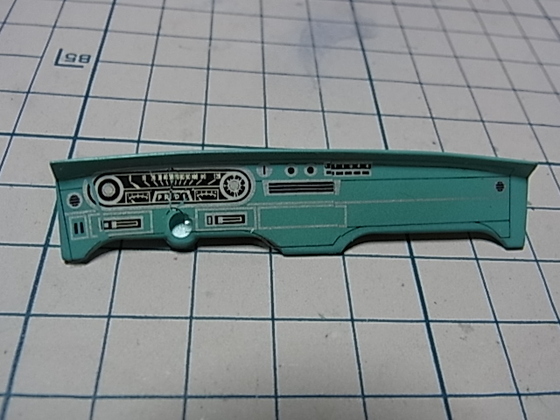-
Posts
9,223 -
Joined
-
Last visited
Content Type
Profiles
Forums
Events
Gallery
Everything posted by peteski
-

Getting really glued in windows out
peteski replied to junkyardjeff's topic in General Automotive Talk (Trucks and Cars)
Ah, the magic water trick. I'm always curious about the results. If the original builder used liquid cement which melted the plastic pieces together then good luck (with any method other than mechanical). -

1:1 "Model Kit"
peteski replied to Jimmy Wilson's topic in General Automotive Talk (Trucks and Cars)
-
You're welcome, and congratulations!
-

Scale size?
peteski replied to KBryan67's topic in WIP: All The Rest: Motorcycles, Aviation, Military, Sci-Fi, Figures
That sounds like the 1:96 Revell U.S.S. Constitution kit. I built 1.5 of them years ago (one completed and 2nd never finished). You might be able to find an older version on eBay for not too much money. -
Is there a gold version of the chrome marker? Like polished brass?
-
. . . and of course they will be fully functional. Just kidding of course (or will they)? Seriously, superb job on everything - I love watching this thread.
-

Otaki 1/12 Lamborghini Countach Twin Turbo...Mission Statement
peteski replied to Dann Tier's topic in WIP: Model Cars
Nice! No, mine is mothballed - I have way too many projects going on right now (model cars, model trains, honey-do things, and the list goes on). I can't wait to see the photos of your progress.- 363 replies
-
- otaki
- lamborghini
-
(and 2 more)
Tagged with:
-
I believe it was also SNL, but I didn't find it in a quick search.
-
We have recently lost our club's president (Del Paone), but the show must go on. I once again invite everybody to join our annual model exhibition and contest. Lots of contest models, vendors and delicious food. Loads of fun and camaraderie! Show flier is available here and contest entry form here .
-
Anybody remember "Adobe the Clay Car" fake ad from SNL? https://www.hulu.com/watch/273955
-

Thank Goodness!!
peteski replied to StevenGuthmiller's topic in General Automotive Talk (Trucks and Cars)
Think of it as a work of art. That suddenly makes the price appear appealing! -

2019 GMC Sierra ( UGLY Truck)
peteski replied to ranma's topic in General Automotive Talk (Trucks and Cars)
Metal?! It is all plastic up front nowadays! -
Yes, that Lincoln Mk. V is one of my favorite cars too. I love the sleek and angular lines and the long hood/short back proportions. I saw one this weekend at https://www.cruisingdowntown.com/ . It was sort of salmon color. My 1985 Eldorado is few feet shorter, but still has the same look. I showed it at the Cruising Downtown and heard lots of positive comments and reminiscing from the public. I also owned a '77 T-bird (cream/brown) for few years. It was a pretty car and a very comfy ride. Again, long hood/short truck proportions. Makes the car look good and sleek.
-
The interior is on the shallow side, but doesn't look too horrible. But the flat dashboard with a decal over it is weird! Maybe someone will come out with a 3-D printed replacement. The body seems to look good (to my non-expert eyes). EDIT: I translated those Japanese blogs and the model featured in the blog is the model released in the '80s. Maybe the current release will have a better dash and interior? One could hope.
-
Come on guys, lets get real here. The way the technology is advancing, by 2045 everybody will be into virtual reality (similar to the holodeck on the U.S.S. Enterprise in the Star Trek TNG). Nobody will want to get their hands dirty messing around with some ancient automobile carcass. If there still are any gearheds left, they will work on virtual vehicles in their holographic simulation of a garage or a racetrack. The young generation even now is not all that thrilled with driving or even owning a vehicle. Driving to them is a huge distraction taking them away from their communicators, and actually owing a vehicle is too complicated and too expensive. Then there is the infrastructure. By 2045 all the vehicles (cars. trucks and personal transport pods) will be all electric, self-driving, and all the roadways will have been by then adapted specifically to those vehicles. They will all be traveling most efficient way, and the most efficient speed. Old manually-controlled and gas-powered cars will not be allowed into the autonomous vehicle collective on the roadways. I'm glad that I will likely not be around to witness all of this in person. Going back to the past, I actually prefer seeing those unloved vehicles restored and exhibited at car shows. If I see bunch of '57 Chevys, '60s Vettes and G nicely restored Gremlin, Pinto Wagon, or a Pacer, guess which cars I will walk by, and which will stop and look at? Yes, the unloved ones because in this day to me they are rare and unique. Chevys and Vettes are dime-a-dozen at any car show. When I attend cruises in my 1985 Caddy Eldorado Biarritz (yes, it is 33 years old already), my car is most often the only one like at the cruise. My Caddy it is 33 years old now, which is the same age as a 1957 Chevy was in 1990, but it is not considered a classic vehicle. Probably will never be either. But I don't care.
-
Łukasz, "worm" means "robak". I think that you meant to write "warm" or "ciepłe". Silly English language . . .
-
Welcome to the forum Łukaszu! Good to see you get back in the hobby. I'm sure you'll get plenty of good advice from the forum's members. I can't help noticing that you have unmistakably Polish name, and you have your location listed as Bristol. Is that in UK?
-
I agree on all counts. Ronsonol is pure Naphtha which is the same as VM&P Naphtha (Varnish Maker's & Painter's Naphtha) is a mild solvent sold in hardware stores (and much cheaper than Ronsonol) I get mine in gallon size can. Since it can be used as thinner, it can attack enamel paints like Testors (but lacquers are more resistant to it). It is excellent as a degrease and for removing pressure-sensitive adhesives (like what is used by masking tape). I often use it to clean non-clear styrene parts prior to painting them. Here is more info: http://www.kleanstrip.com/product/vmp-naphtha Also do a Google search for "vm&p naphtha"
-
I'm a bit confused. So do you love tech, or simplicity, in a *contemporary* car? It sounds like you really love your gadgets, but if they made a simple stripped car you would forgo all your conveniences and love to own a simple car? Or you would love it for others to buy and drive such car? You can't have it both ways .
-
Great to see those Aoshima MGs finally reissued - they fetch ridiculous prices on eBay! I have one from 1998 when it was imported by American SATCO! Speaking of SATCO, boy do I miss all those nice tire sets they offered. I have a feeling that they were all made by some Japanese kit manufacturer.
-
I have 2 Dremels. I use one handheld while the other one has a flex shaft attached. I then hung it on a home-made stand. Went to Home Depot and bought piece of electrical conduit, a 90 degree elbow and some coupling pieces. I then used 2 conduit brackets to mount the vertical piece to the shelf on my bench. The Dremel is suspended by a chain threaded into the conduit. It is held in the conduit by a removable pin made from a pip-rivet. That way I can easily adjust the height of the setup. The photos shows that setup on a very rare occasion when my workbench was just cleaned.
-

New updated Model Car Garage site!
peteski replied to MrObsessive's topic in Car Aftermarket / Resin / 3D Printed
Congratulations having your model featured on their website Bill. I was just as excited when my model was used on the Bare metal Foil packaging (and in some of their magazine ads in the early 2000s)! More so than winning any contest trophy. -

Revell Hemi - Hydro
peteski replied to Hi-Po's topic in WIP: All The Rest: Motorcycles, Aviation, Military, Sci-Fi, Figures
So it likely is from one of those old East German airplane kits. The boat does look great!


